Homebrewing is one of my favorite things to do, but I especially love it when I can incorporate foraged ingredients. I came across some nice big spruce tips recently, and when I saw them I immediately knew what I was going to make with them: spruce beer! Homemade spruce beer has been something that I’ve been wanting to make for some time, but it just hadn’t happened yet until now. This spruce beer recipe isn’t complicated and the end result is delicious!
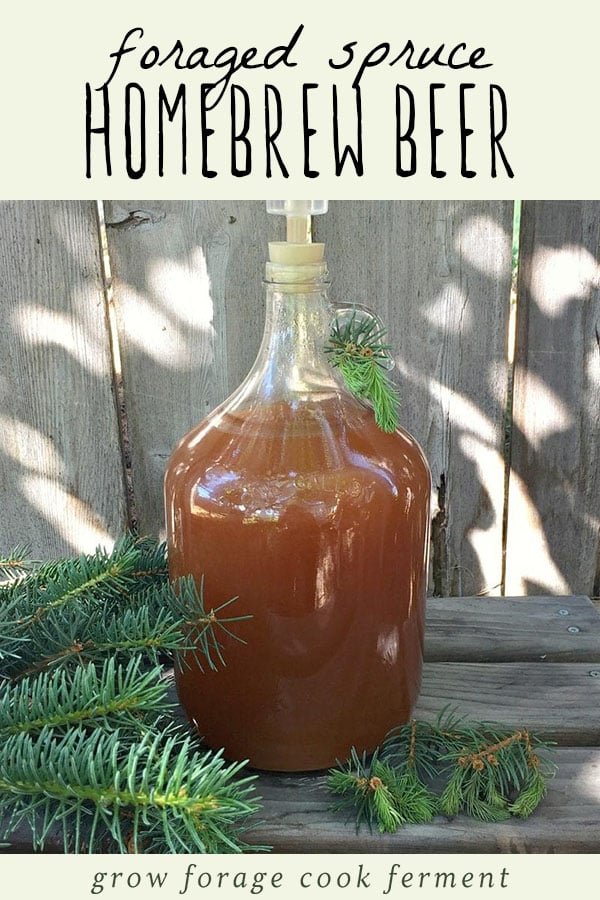
Want to save this post for later?
Harvesting Spruce Tips
Spruce tips are the bright green new growth on the end of spruce tree branches in the springtime.
Using spruce tips in this recipe is preferred, but they are generally only available for a short time during the spring. Exactly when to find them varies from location to location depending on your climate.
Warmer regions will get spruce tips in late winter or early spring, and cooler regions in late spring or possibly even during the summertime.
Related: How to Identify Conifer Trees: Pine, Fir, Spruce, Juniper & more
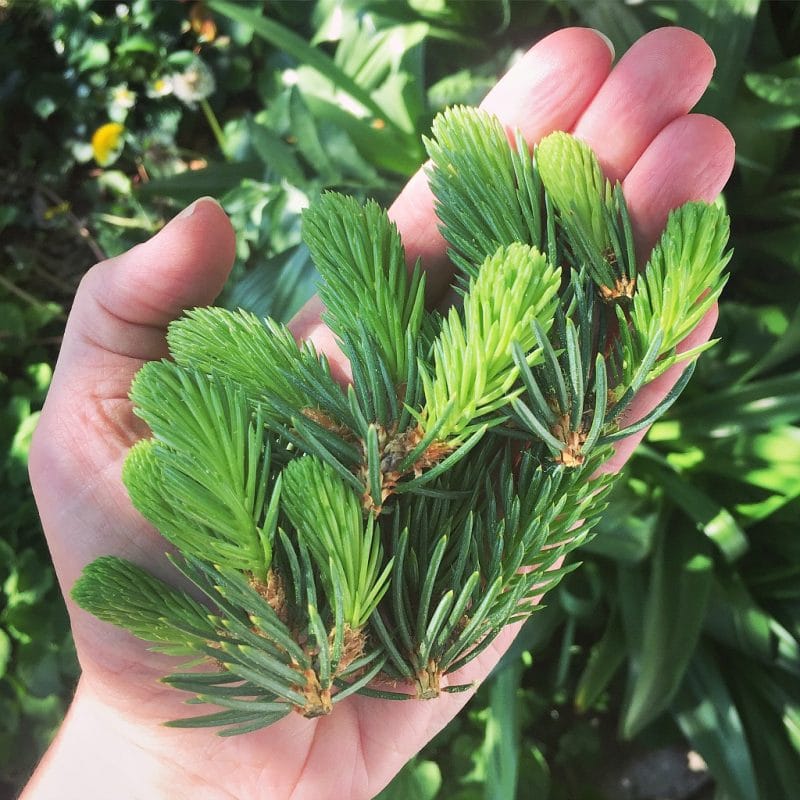
Try not to pick more than a small handful of spruce tips off of each mature tree, and avoid taking any tips from smaller trees.
If it’s the wrong time of year for spruce tips, you can use spruce cuttings from the older growth. The flavor will be different, a little more piney perhaps, but still good.
You can also use the tips or older growth of any edible conifer, such as pine, fir, or hemlock (the tree, not the poisonous plant). Be sure to avoid the yew tree as it is toxic.
Spruce Beer Recipe
This is not a traditional beer recipe that uses hops and malt, but more of an old-fashioned foraged brew.
Feel free to add in some hops and malt if you are looking for more of a beer-like flavor. I really wanted the flavor of the spruce to shine in this recipe which is why I made it this way.
This recipe calls for champagne yeast, but you can also use a wild yeast starter in the same manner that I did in this mugwort lemon beer recipe instead.
Before you start brewing, you will need some equipment. Sanitizer is important, and a one gallon jug with airlock is needed for fermenting. Check out my page on mead brewing and bottling equipment for more.
How to Make Spruce Tip Beer
Mix the water, brown sugar, and spruce tips in a large pot. Cut and squeeze the lemon into the pot. Bring to a boil and let it boil for 30 minutes.
Place the pot into a pan of ice water until the wort has cooled to room temperature, about 70°F (21°C).
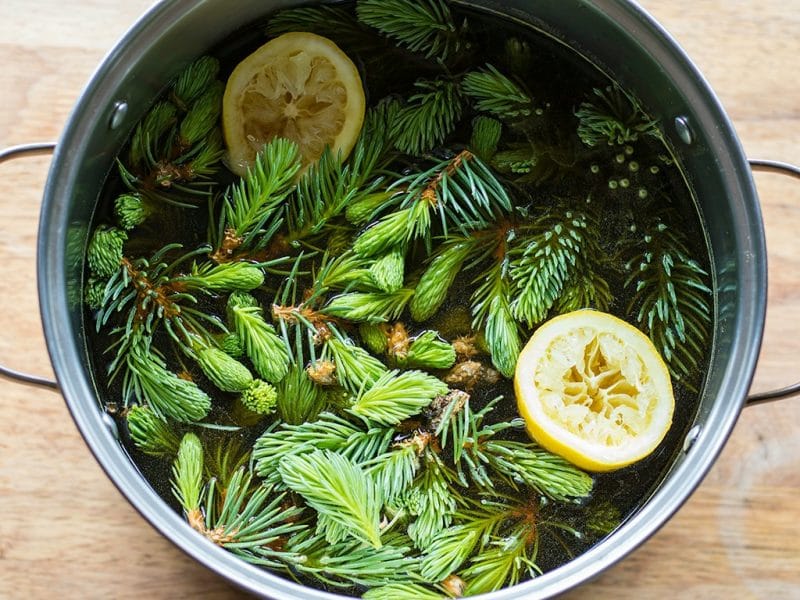
Strain the wort into a one gallon jug, leaving 2-3 inches of head space at the top, then add the yeast. Cap the jug with a lid and give it a few shakes to combine and aerate.
Put a bit of water in the airlock to the line, then position it on the jug. Let the spruce beer ferment for at least 2-3 weeks, until the bubbles in the jug have slowed significantly but not completely.
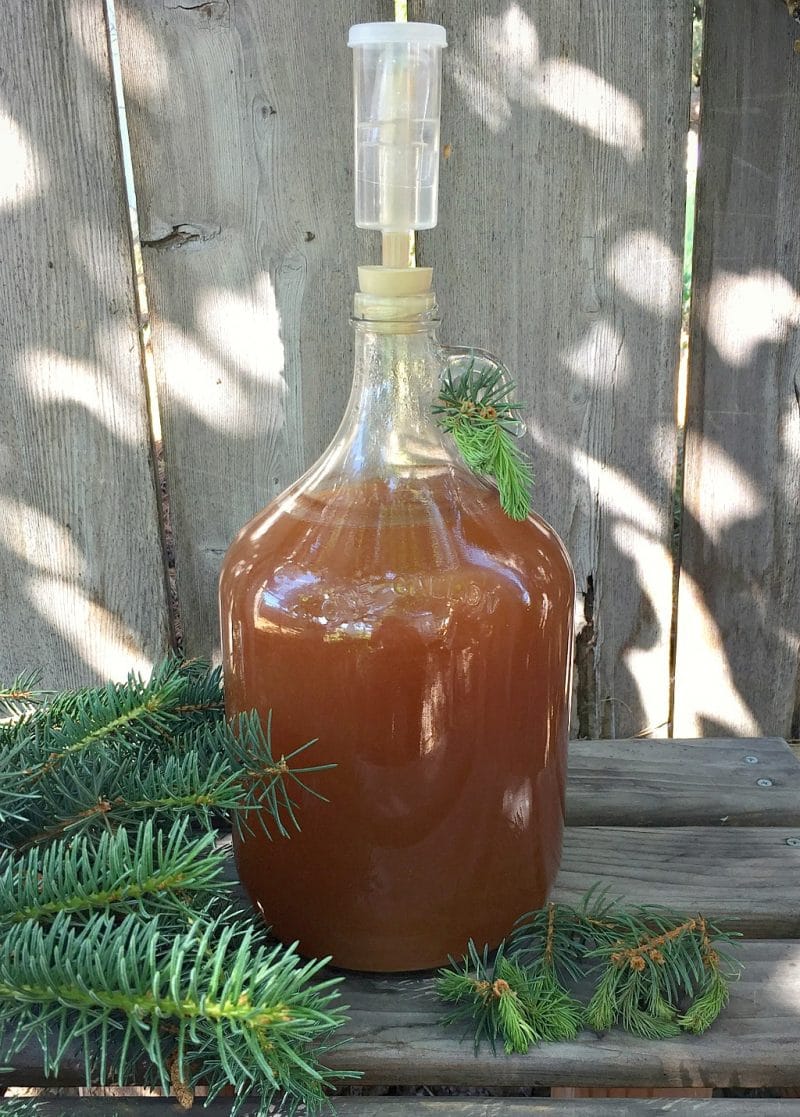
Bottle the beer using the bottling instructions on this page. Let the bottles sit for 3-4 weeks before drinking. Serve cold!
I really love how this spruce beer turned out! It has a pleasant and barely sweet pine-like flavor without being overwhelming. The champagne yeast makes it quite dry, which is how I prefer it.
It’s refreshing when served cold and has a wonderful bubbly carbonation to it.
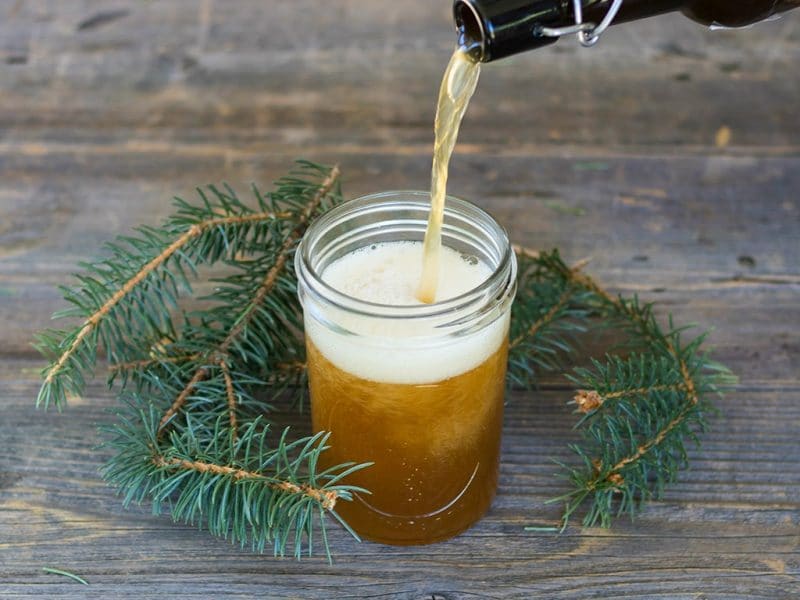
Even though spruce tips aren’t in season in the fall, this would be an excellent recipe to make for the holidays with any type of conifer needle.
I hope you try this spruce beer recipe. If you do, let me know what you think!
If you enjoy foraging for spruce tips and other conifer needles, here are 30+ Conifer Needle Recipes for Drinks, Desserts, Syrups, Balms & More!
More Homebrewing Recipes
Ready for your next brewing adventure? Try one of these tasty recipes!
Spruce Beer
Equipment
Ingredients
- 1 gallon water
- 3 cups dark brown sugar
- 4-6 ounces spruce tips or spruce cuttings
- 1 lemon
- 1/2 package champagne yeast
Instructions
- Before you begin, sanitize all of your brewing equipment.
- Mix the water, brown sugar, and spruce tips in a large pot. Cut and squeeze the lemon into the pot. Bring to a boil and let it boil for 30 minutes.
- Place the pot into a pan of ice water until the wort has cooled to room temperature, about 70°F (21°C).
- Strain the wort into a one gallon jug, leaving 2-3 inches of head space at the top, then add the yeast. Cap the jug with a lid and give it a few shakes to combine and aerate.
- Put a bit of water in the airlock to the line, then position it on the jug. Let the spruce beer ferment for at least 2-3 weeks, until the bubbles in the jug have slowed significantly but not completely.
- Bottle the beer using the bottling instructions on this page. Let the bottles sit for 3-4 weeks before drinking. Serve cold!

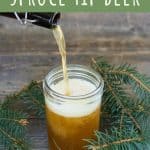
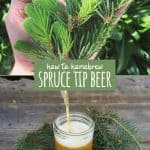
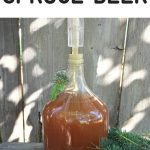
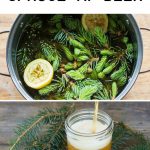
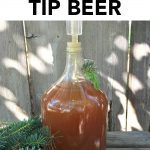
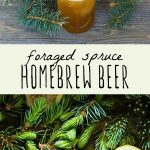
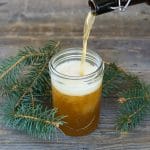

Hello, I see you said you could add hops and malt for more of a beer flavor. Should I add those in when it boils? And strain it off?
Yes, that’s right. I would add during the boiling process and strain with everything else.
Hello, I realise the post is quite old but I wonder whether you consider that I could use (air) dried Spruce needles as a substitute for Spruce tips? I have read that is may be more bitter? Any advice welcome. Thank you for your work. Stephen
I haven’t tried, honestly, so I can’t really say. You can experiment with them in a small batch to try them out.
How does the spruce flavor come through? Does it predominately just taste alcoholic? Do you do a secondary ferment? It’s basically a spruce mead but using brown sugar instead of honey. Is using sugar vs honey done just from a cost standpoint? I just set up a batch yesterday on the 4th so will report back how it goes in a couple months. Thinking I’ll do a secondary ferment and add more spruce tips as well as some berries to impart a bit more flavor depth.
I am curious would any juniper berries work to make the wild yeast? I do not know how many varieties of juniper there are or if any are toxic. I appreciate the champagne yeast substitute-I have that! Lastly I learned how to make spruce tip cough medicine from my mother who was born in Austria. You will find “fir tip” couch medicine, liquor and wine for sale in Austria. All delicious!
Hi there. Some juniper berries are toxic, so I would make sure to identify the species you have prior to foraging it.
I’m in the process of bottling is this recipe supposed to have a sour taste. I tried to be careful sanitizing?
Hi Lee. I’m not sure what the question is you’re asking.
I was trying to get an idea of the taste this should have when finished. I opened a bottle after 1 month and it was somewhat sour, almost like some wines I’ve had. I know in brewing beer it can sometimes get contaminated and develop a sour taste. If I screwed up I’ll try again next spruce tip season.
Hi, I made this approximately a week ago and nothing seems to be bubbling or fermenting yet. Is that expected? When your instructions read 1/2 pkg champagne yeast are you referring to a package in the size of 5 grams? So then, 2 1/2 grams of yeast?
Hey dude, I usually brew cider but what I’ve heard from the folks at the homebrew shop is that there isn’t really a consequence to overpitching, but underpitching definitely impacts how the yeast colonizes the brew. I’ve heard that a lot of champagne yeasts are very slow and can often strip flavours of your homebrew, I’d try my favourite ale yeast, Safale S04 by Fermentis. It’s got high flocculation and usually starts quickly. Shouldn’t need more than a 1.5 tsp to get it started. Also crucial is making sure that the jug is shaken after pitching the yeast. Good luck!
Have you ever made this recipe without adding yeast at all? I make a variety of wild brews (using mugwort, sumac, yarrow, etc) and if I am making a lower % alcohol content (less than 6%), I use a “wild” yeast starter as my yeast source. (If I make a wine with a high alcohol content I need to use a commercial yeast as the wild yeast can’t survive.) Spruce tips actually contain wild yeast when you pick them, as well as other fruits that have that white ‘waxy’ coating. So I add spruce tips to a jar, add a sugar source (honey or sugar) and fill it up with water, in a few days I have a bubbling solution. Then I add that to my plant/sugar brew solution, and it becomes active in a day. So I would assume that I could make the Spruce ‘beer’ without an external yeast source as the Spruce tips would have the wild yeast on it. I am soon to try it, and I will let you know if it works out!
Sounds amazing! Can I replace the brown sugar with honey, and if yes, the same amount or more or less? Thank you!!
You can sub 3/4 cup honey for every cup of brown sugar.
i apologize in advance for being pedantic, but: this isn’t a beer. it’s a wine. by definition, the fermentables in beer must come from saccharification – the conversion of starch into sugars (that’s what brewers do when mashing, AKA cooking, the grains before boiling the resulting liquid). wine, on the other hand, is made directly from juice and/or sugars – direct access to the fermentables, no conversion from starch required. but: a rose by any other name… :-)
Hi Andrei, i just wanted to clarify about Spruce Beer. It’s just it’s name, like root beer. Except this tastes like one licked the smell of a spruce tree. Very popular in Quebec Canada.
Hi there! Thanks for a fun recipe – I’ve got a lovely carboy full of this spruce ale going now! Unfortunately as I was pouring the tea into the carboy a couple sprigs of spruce slipped in and are now floating on top. Should I siphon it out into a clean carboy, or let it be? I’d hate to ruin the whole batch from mold or something.
Hi Katie, if it were me I wouldn’t worry about it and just leave them! The alcohol content that forms will prevent any mold from occurring.
Hi there,
I have brewed some ale and mead before, but I’ve just fallen in love this recipe. My only problem is that in the local beer makers shop there is no champagne yeast, only lager, ale, cider and mead yeasts. I’m not really comfortable with lager yeasts due to their temperature needs.
My question is if it would work nicely with a high alcohol tolerance mead yeast or some premium ale yeast (I have one 1 package leftover from the last brew)?
I mean, I know these would produce alcohol and CO2 just like the one in the recipe (or with the wild yeast starter), I’m more concerned taste-wise.
Have anybody tried it with these kinds of yeast?
Hi there, I would try the mead yeast first and see how it works!
I want to try with pale ale style yeast. What do you think?
I haven’t tried it, but I’m sure it’ll work!
Do I have to add something more to the bottles for it to self carbonate? sugar and yeast or just sugar? If so, how much?
I suggest you use a priming calculator to determine how much sugar to add to your homebrew: Priming Sugar Calculator
The yeast and sugar are in the recipe. Nothing more should be necessary. Yeast will either eat all the sugar or the brew will become too alcoholic for the yeast.
The rule of thumb is 10g of pure sugar per liter. Add about 5% more if you use honey, LME, or a syrup. The priming sugar calculators always make me undershoot the sugar needed for carbonation. I have found this advice from the Italian guy on Youtube that makes beer, wine, other boozy treats, and aged meat. I have also used 10g per liter and it worked well.
Spectacular!
Delicious beer. I made this recipe and really enjoyed the brew. I plan in making it again this coming spring when the spruce tips are budding again. When I do make it again, I plan on making several batches: the original, because it is so yummy, and I also plan on experimenting with the recipe to make variations of this spruce tip beer.
Regardless, it is a delicious recipe just as it is. I am being stingy on the few bottles I have left, because I don’t want to run out of it!
Thanks for sharing.
Thanks for sharing! I’m so glad you liked the spruce beer!
First, I love your site.
Second, I have been wanting to try this beer recipe for over a year and finally did this season. I opened and tasted my first LARGE bottle with 2 other testers… It is odd tasting with the flavours intriguing enough to keep sipping on the brew until it grows on the taste buds. My taste bids want more, but the alcohol content tells me to stop…. It is STRONG! I have a colleague who has the equipment to determine the alcohol content, so I will be sharing this beer with her and we will test it in that area.
I would like to make this recipe again, but use fir tips and an ale yeast. Just for the adventure of experimentation.
Thank you for your sharing. I appreciate it.
Does anyone know what the alcohol content is in this recipe?
One more thing, I made a 3 gallon batch by adjusting the volume of the ingredients.
Greetings, this is my first attempt at beer making although I regularly harvest spruce tips for making kombucha and jelly. I deviated from your recipe in that I used raw sugar instead of brown sugar (although my raw sugar could be considered brown) and I used a beer yeast instead of champagne yeast from my local store. I added approximately 6 oz from an 11 oz packet of the yeast to the wort and didn’t see any bubbles in the airlock after 4 days. I cracked open the lid to the fermenting bucket and didn’t see any sign of yeast activity (frothing or bubbles) so I added the rest of the yeast from the 11 gram packet. Both times I hydrated the yeast in water at temp between 85 and 95 degrees F. Being new to this, I am worried that I won’t get beer. What should I do if I still don’t see bubbles in the airlock after a few days? Should I try a yeast booster, or should I get the champagne yeast? Thanks!
Firstly I’m confident you used enough yeast that it should be doing its thing. I’ll add an approximate 2.5 grams of dry yeast to my 2.5 gallon brews. I’d guess either the water you’re rehydrating with is too hot or too chlorinated for the yeast, or the yeast is expired and too old.
I’ve had trouble using beer yeast when not using malts (barley usually). The yeast is different and need different types of sugars. Wine/cider/mead yeasts woek best for non-malt bevvys. Make sure you’re fermenting at the appropriate temp for the beer yeast, as they are more finniky.
How long did fermentation take to start for you all? I’m on 72 hours and I got a few bubbles with no rising yeast. I used champagne and stored at 62-65f
I recommend making it over a fire, I brewed a batch over an open fire and it has a wonderful smokey flavour, love these simple recipes they can often turn out much better than more complex ones.
This brew sounds delicious. I would have expected the carb count to be much lower than 36 grams per serving after fermentation. How does one determine this?
Why so much residual sugar after pitching? If the yeast is doing it’s job, most brown sugar should convert to alcohol? What is the abv? Did you have a OG and FG reading….asking for a friend!!!!
What does 4-6 oz of spruce tips look like as volume? I won’t be carrying a scale out to the woods to collect tips. TIA
a few cups to a quart should probably do it.
This was great! We were a little put off at first sip bc it’s such an unusual flavour, but after a few more sips everybody is hooked – it really grows on you. Have since finished that batch and husband has already asked multiple times for me to make more. Surprisingly malty. Alcohol content sneaks up on you, though. Really nice recipe, thanks!
Hi, I just bottled my first batch of spruce beer but I noticed that the beer looked rather clear (almost like water) and it had a very weak scent. When I got to the last bottle some pink slimy fluid started coming out of the spigot. I’m sure this means the batch is ruined but do you know what could cause this? I made sure to sanitize everything beforehand so I don’t think it’s that. Thanks.
Hi Mike, I’m not sure why it became so clear like that, but the pink slimy stuff is most likely just the “lees” at the bottom of the bottle. This is a normal by product of brewing, and doesn’t mean that the batch went bad. Did the brew bubble and ferment for a while? Does is smell and taste of alcohol? If so then I think everything is probably fine!
Hey, the stuff at the bottom is your yeast that got happy and ate the sugar in the batch. I too used to think the same when making wine. WRONG! Save for your next batch!
I just bottled mine so it still needs to carbonate (I primed with 1/2 tsp corn sugar per bottle), but it already tastes amazing! Almost like a sour ale, I was very surprised that it has a bit of a malty flavor in spite of the lack of grains. I’ll definitely be making more batches in the future, thanks for sharing the recipe!
CAn you use juniper berries in this recipe in place of the yeast, or in addition?
sorry what weight is the yeast? not all packages are created equal
Caitlin,
Yeast will self-regulate. A packet will do the trick, regardless of whether it is an 11g “brewer’s packet” or a 21g “baker’s packet.”
The yeast will proliferate, eat the sugar, and then slowly starve to a dormant, near-death state once there is too little sugar for it to eat and too much alcohol for it to be comfortable living in.
I question the recipe’s choice of champagne yeast, to be honest.
If I were to brew this recipe, I would do two batches side by side: one with champagne yeast, and one with Safale’s US-05 strain.
Is there a way I can email this recipe to me? I’m away from home and can’t print it and so don’t want to loose it. Thank you so much for sharing!
I am completely new to any type of beer/mead/wine-making, but I’m curious as to your thoughts on possibly substituting honey for the brown sugar. Would the fermentation time have to be increased to that of mead, or might it work as the recipe above?
Thanks for the Spruce beer recipe! I love old-timers recipes and all natural medicinals. Best regards from a friend in Texas.
is 4-6oz. of spruce tips by weight or volume?
I was wondering that myself.
My other question is, if you brew this in the spring, what is the longest it will keep in the fridge?
Will it keep until winter?
As far as I am aware, as long as your brewing and storage equipment is sterile, it shouldn’t go “bad” at all… That’s the beauty of fermentation.
Yes, since it is alcohol it has a long shelf life and will last for quite a while!
By weight, thanks for asking :)
I did mine by weight with a scale. I used 6 oz. I’m also curious what temperature the fermentation was at for those two to three weeks? I’m assuming just room temperature? 68-72 F?